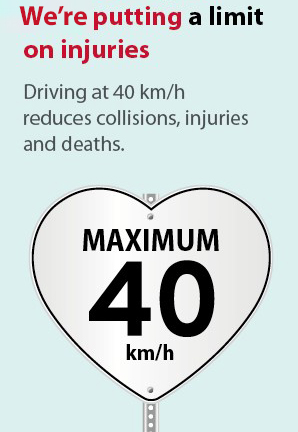Neighbourhood speed limits
In Calgary, the default unposted speed limit is 40 km/hr. Drivers must stay at or below that speed on any road that does not have speed limit signage.
In Calgary, the change to the standard speed limit from an unposted 50 km/hr speed limit to 40 km/hr came into effect on May 31, 2021. It impacted the speed limits on both residential and collector roads in neighbourhoods. There were no changes to speed limits on higher classification roads (e.g. Deerfoot Trail, Bow Trail, Anderson Road, Memorial Drive) or playground zones.

Calgary speed limits map
This map shows the maximum speed limits throughout Calgary. It does not list the default residential speed limit of 40 km/hr, which was reduced from 50 km/h to 40 km/h effective May 31, 2021.
What roads have new speed limits?
Changes to speed limits in neighbourhoods only applied to residential and collector roads. There were no proposed changes to playground zones or higher classification roads (e.g. Deerfoot Trail, Bow Trail, Anderson Road, Memorial Drive etc.)
- Residential roads are the roads in front of most houses, typically have no center line, and have less traffic.
- Collector roads have residences, schools, businesses, green spaces, typically have a center line, and are often bus and snow routes.
To determine if it is safe for a collector road to have a 40 km/h speed limit there were a number of factors considered such as, how long the road is (including playground zones), if traffic calming has been installed on the road (e.g. speed humps, or cushions) if the average speed (measured by a speed study) is consistently below the current speed limit, whether the road has low traffic volume, and whether the road is a bus route. See the criteria we used for collector roads.
How we got here
Speed, and the perception of speeding, is a consistent concern The City has heard from residents. There are an average 9,100 collisions per year on streets inside Calgary neighbourhoods.
At the February 1, 2021 Strategic Meeting of Council the City of Calgary Standard Speed Limit Bylaw was passed. This bylaw, and the detailed technical analysis and cost benefit analysis that was done, demonstrate that a small reduction in driving speed can reduce the chance of collisions. Travelling at a slower speed gives a driver more time to react, broadens their field of vision, and reduces how severe crashes are when they happen. It also gives others, including cyclists and pedestrians, more time to react to an approaching vehicle.
Background Council documents
February 1, 2021 Strategic Meeting of Council
- Minutes of the February 1, 2021 Strategic Meeting of Council
- Cover report
- Summary of previous council direction
- Potential questions for a vote of the electors
- Previous report including technical and cost-benefit analysis
- Proposed bylaw
- Framework for lower speed limits on collector roads (deferred until Q2 2022)
Project background
The Residential Speed Limits Review aims to improve traffic safety for all users by reviewing operating speeds on Calgary’s residential streets. Learn more about The City's traffic safety programs.
In Calgary, traffic collisions account for a total societal cost of approximately $1.2 billion a year which include medical costs, first responder costs, property damage and lost productivity. As part of the Council-approved Safer Mobility Plan, a key target is to achieve a 12 per cent reduction in the pedestrian and bicycle casualty collision rate per population of 100,000 based on a three-year rolling average.
Recent studies have shown that a 1% reduction in average driving speed is expected to result in a 2% reduction in all collisions, a 3% reduction in injury collisions and a 4% reduction in fatal collisions. Reducing driving speeds in residential neighbourhoods can also help Calgarians feel safer and more comfortable when moving around in their community, whether they choose to walk, cycle or drive.

